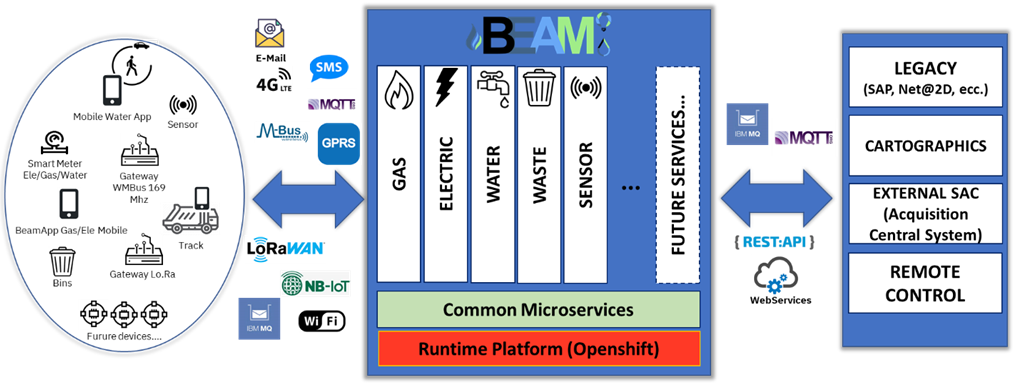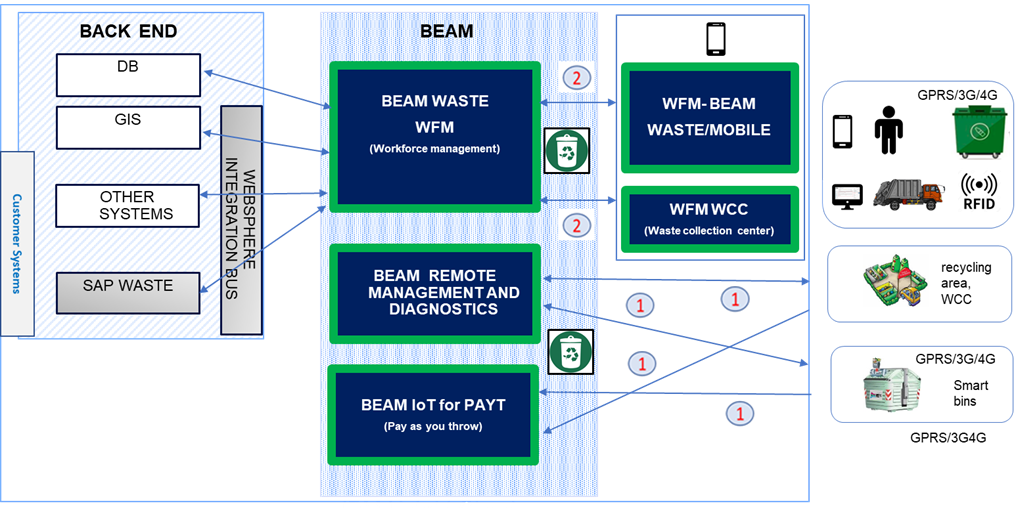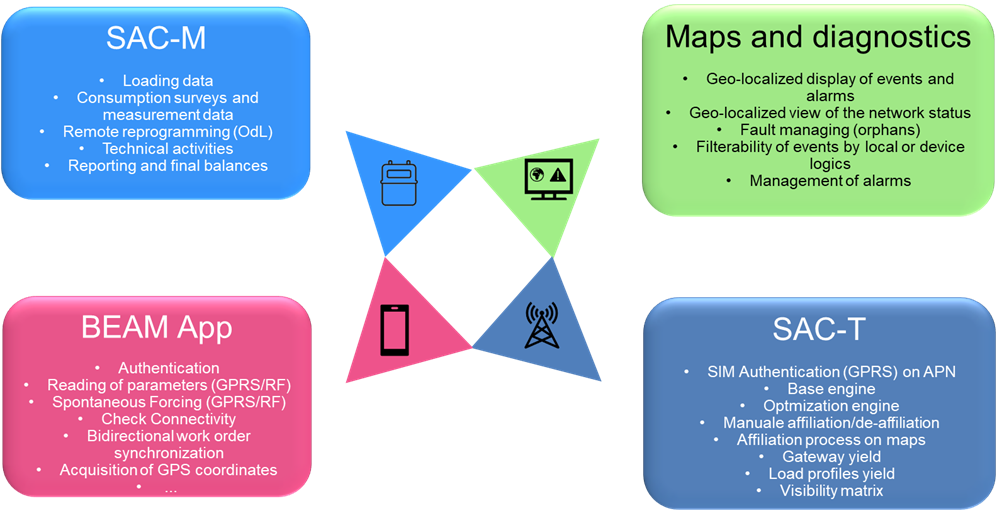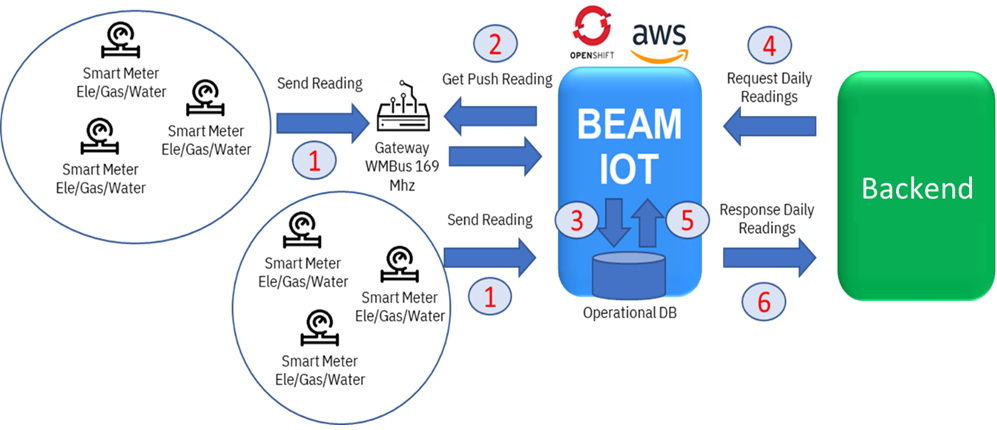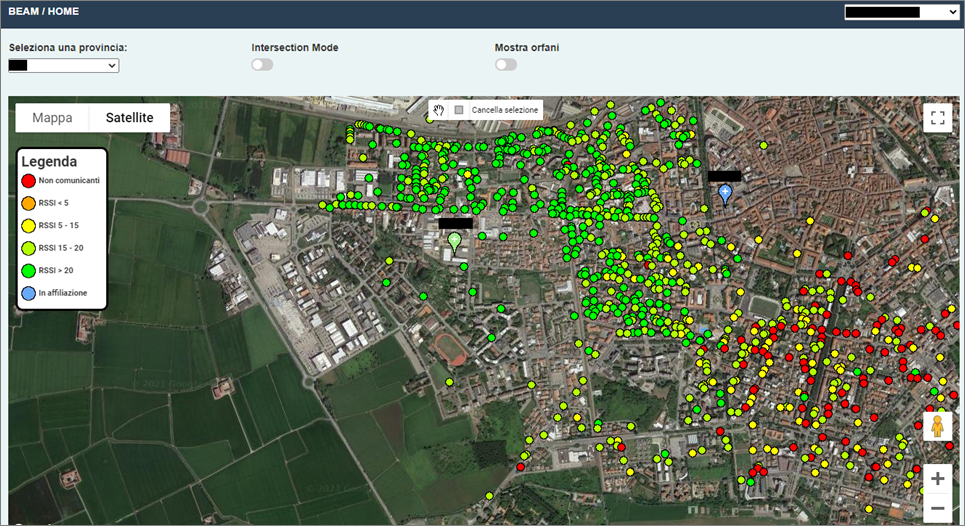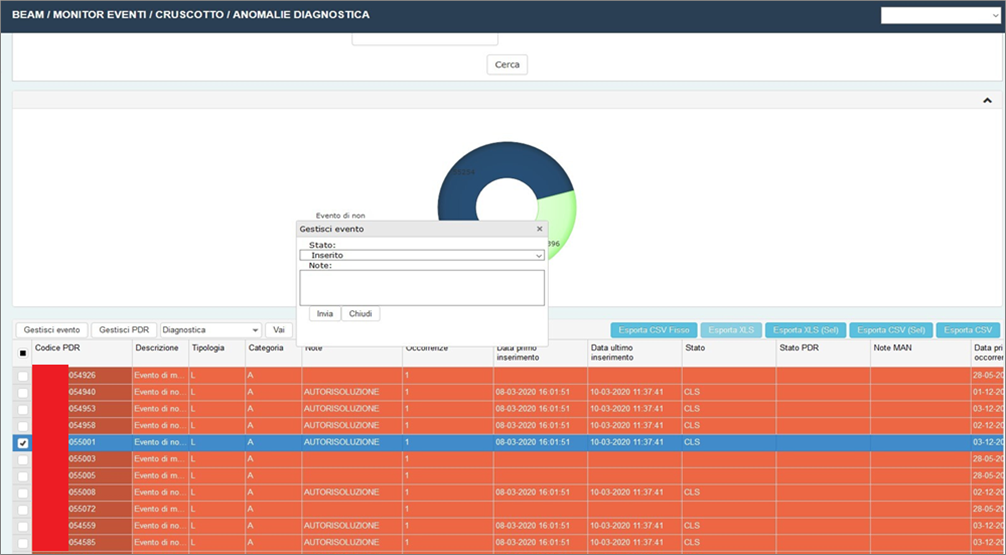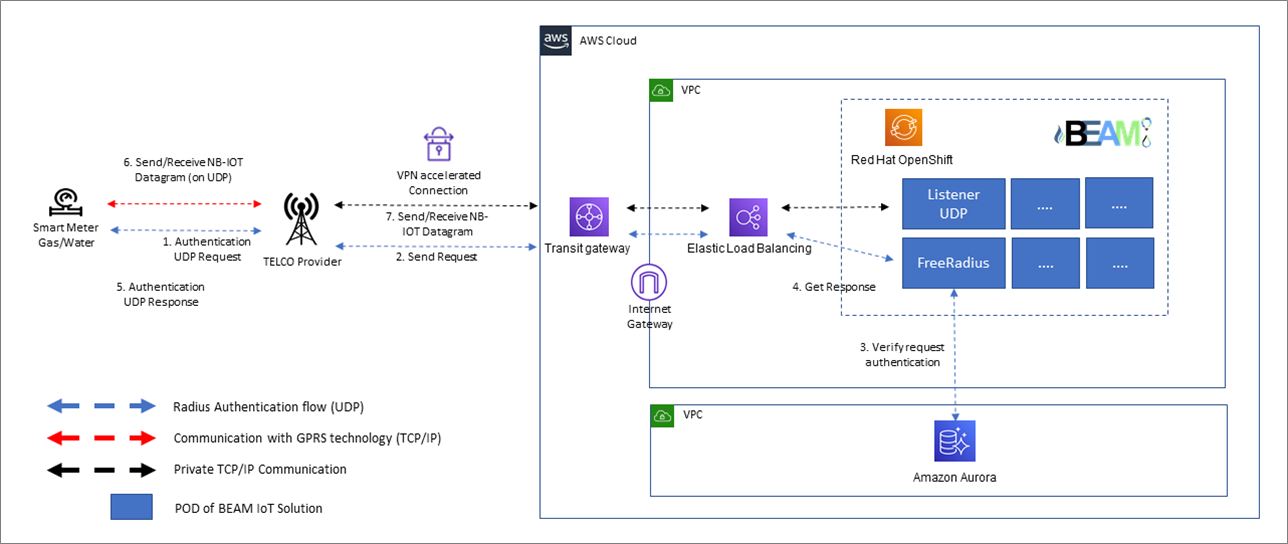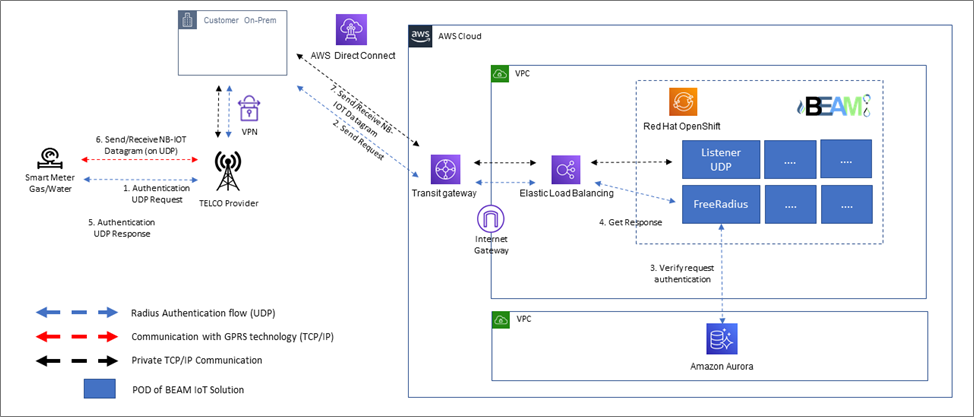AWS Partner Network (APN) Blog
IBM Broadcast Enabler of Automated Metering (BEAM) IoT Solution for Utility Companies
Editor’s note: The Italian version of this blog post is available here >>
By Diego Colombatto, Partner Solutions Architect – AWS
By Fabrizio Marinaro, Account Partner – IBM
By Alessandro Prencipe, Hybrid Cloud Architect – IBM
By Giulia Tieran, IoT Cloud Solution Program Manager – IBM
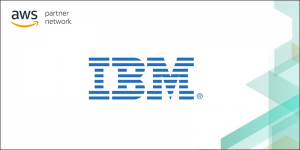 |
| IBM |
 |
Utilities are going through a period of transformations linked to the need to quickly adapt to the new requests of the Energy Authority or other external agents, to govern the services provided to customers in an ever more efficient way, and to respond to new climatic and technological challenges that are evolving worldwide.
These transformations require the use of a reliable infrastructure, designed to manage changes and to ensure the continuity of business processes and services.
The infrastructure must enable the collection and analysis of various information, both for purposes internal to the utility or operations, and for the evaluation and extension to new business-relevant use cases.
A new business model, growing in the utilities segment, is the extension of this infrastructure to smart city use cases, based on the processing and monetization of information collected.
An example, in the Internet of Things (IoT) field, is the collection and reselling of data related to public lights and parking monitoring and management.
Other examples, in the analytics field are the processing of data for reactive and predictive maintenance of field devices (owned by the utility or by third parties) and the ex-post analysis of network protocols available on the territory, to build the real signal coverage heatmap of different network technologies.
To meet these utility needs, AWS Premier Consulting Partner IBM designed the BEAM IoT (Broadcast Enabler of Automated Metering) solution—a hybrid, modular, and flexible cloud solution designed to be adapted throughout its lifecycle to the requests of the Energy Authority and utilities.
The platform can be plugged into different vertical modules, each providing functionalities for a specific segment such as gas, power, or water.
IBM BEAM IoT Solution
BEAM IoT is an open, flexible, and modular system, designed using microservices and open source standards and orchestrated by a hybrid architecture based on Red Hat OpenShift.
The SAC-T, SAC-M, Maps and Diagnostics modules, and backend component of BeamApps (all of which we’ll discuss below) are running on the Red Hat OpenShift Service on AWS. This architecture enables microservices to scale based on application load changes and service continuity by distributing the load across multiple AWS Availability Zones.
BEAM IoT was born as an integrator of the data required for complete “remote reading” and “remote management” of the field equipment in the gas, water, and electricity domains. It was subsequently extended to environmental management (waste collection and delivery, street sweeping) and to the management of additional IoT devices.
BEAM IoT is a multi-company (multi-tenant), multi-service, and multi-technology platform, meaning that can communicate with IoT devices on the field using all of the main protocols. It is designed to be quickly extended to new protocols or “dialects” used by specific devices.
The vertical modules currently available are:
- Gas
- Electric
- Water
- Waste
- IoT sensors
Figure 1 – Macro architecture of the BEAM IoT solution.
BEAM IoT Waste
There are two main use cases available for BEAM IoT Waste:
- It’s possible to offer automated waste collection services that allow citizens to deliver their separate waste collection to receive benefits, in the form of points and/or discounts on the waste tax. For this waste delivery method, it’s possible to use smart caps or recycling area, for example.
.
BEAM IoT also offers waste service managers graphical tools for analyzing raw and aggregate data to improve the services performed. These features are offered by BEAM IoT for PAYT module, which collects business metrics related to separate waste collection. The BEAM Diagnostic Remote Management module collects the technical data related to separate waste delivery, and offers monitoring and remote management functionalities.
. - It’s possible to offer workforce management functions to waste collection companies such as scheduling, monitoring, final accounting, and efficiency improvement of special and non-special waste collection activities.
.
BEAM IoT offers two mobile apps for this use case. The first is aimed at waste operators and shows information necessary for waste services execution, such as the route to be followed and bins filling level.
.
The second is aimed at citizens and offers various functions such as special or bulky waste collection request. This provides information on separate waste collection and viewing information, like the days and places scheduled for waste collection and the balance of points
Figure 2 – BEAM IoT Waste high-level functional architecture.
BEAM IoT offers two mobile apps for this use case. The first is aimed at waste operators and shows information necessary for waste services execution, such as the route to be followed and bins filling level.
The second is aimed at citizens and offers various functions such as special or bulky waste collection request. This provides information on separate waste collection and viewing information such as the days and places scheduled for waste collection and the balance of points
IoT Sensors and Further Use Cases
The IoT sensors vertical module includes the devices BEAM IoT can be integrated with, and those which are not associated with any specific vertical but enable additional use cases.
For example, once a gateway network (WMBus or other protocol) has been installed in the field, to integrate with the meters BEAM IoT allows you to acquire data from other devices that can be reached with the same protocol.
These devices could be of different types—such as parking sensors, lighting devices, or surveillance cameras—and could belong to a third-party company interested in acquiring the data and/or managing these devices without having to implement and directly operate the necessary management infrastructure.
A further example is safety in residential construction. In this case, BEAM IoT allows you to collect data, images, and videos from the devices in, or near to, the building. The collected data can be processed in the field—that is, before they are sent to the AWS Cloud—through data analysis algorithms (machine learning models or other).
The data, processed and/or raw, can then be sent to the property manager with the objective of metric collection, monitoring, and alarms.
Another example is the BEAM IoT capability of managing smart-meters, or meters equipped with additional sensors such as detection of oscillations, vibrations, or pressure. BEAM IoT can acquire and manage information from these sensors and enable use cases such as sending notifications of environmental events (seismic shocks) or related to the property, like volumetric and perimeter alarms.
Functional Architecture
The BEAM IoT solution covers the entire cycle of “remote reading” (acquisition of readings, events, alarms, and telemetry coming from the field) and “remote management” (cycle of work orders for ordinary and extraordinary management).
It is composed of four macro functional modules:
- SAC-T
- SAC-M
- Maps and diagnostics
- BeamApp
Figure 3 – The macro modules that are part of the BEAM IoT solution.
SAC-T (Central Acquisition System)
This component is responsible for communication with field devices (meters, sensors, and gateways). Its main purpose is to make the network and communication with the central system efficient.
The module provides complete network management through an automatic engine, which deals with the dynamic association of devices with gateways, to achieve maximum communication efficiency and sends the collected data to the analytics module.
An example of why it’s necessary to use a dynamic meter-gateway association is the efficiency of communication that changes over time. Think, for example, of the growth of vegetation or the modification of the urban landscape; these changes can render the efficiency of a given meter-gateway link (for a given protocol, WMBus, LoRa) less efficient than other meter-gateway links.
When the module detects that a more efficient link exists, it switches the association from the less efficient link to the more efficient one.
SAC-M
This component is responsible for the acquisition, validation, and historicization of data, and the production of reports. It acquires data, decrypts the payload containing business data, applies various checks to verify the validity of the data, including fraud checks, processes diagnostic data, and persists data on the database to make data available to other BEAM IoT components and third-party systems.
An example of customer third-party systems that use this data are the management systems (CRM/ERP) that process invoices and send data to the Energy Authority.
SAC-M itself uses databases to produce reports, such as efficiency reports providing daily, monthly, or other duration KPIs like the number of counters sending data with respect to the total number of meters installed, number of counters sending invalid or duplicate data, or number of anti-fraud hits generated.
Analytics Module (Maps and Diagnostics)
This component offers a presentation layer with dashboarding, reporting, and data analysis functions. Both technical and business analysis are possible.
Technical analysis is relevant for the network manager, such as the possibility of showing on a geographical map the field devices with the desired metrics (signal strength, battery status, date). These analyses also enable predictive maintenance use cases from, for example, the point of view of planned failures and maintenance.
Business analysis is relevant for analysts and other business personas, and allows analyses such as the daily and over-time comparison between equipment efficiency and minimum required value, the verification of data quality, and analysis on the type and number of pricing plan change requests.
BeamApp
This macro-module includes multiple mobile applications, mainly used for the installation, replacement, reprogramming, and removal of field equipment (meters and sensors). With reference to the gas service, the app is used for the “emergency intervention,” while for the water service it is used for walkby/driveby type activities.
Figure 4 – Examples of functionality BeamApp Water – Walkby / Driveby.
BEAM IoT Workflow Example: Gas/Water Remote Reading
Next, we will look at a real example of data flow, taken from BEAM IoT implementation in production.
The image in Figure 5 shows an example of gas and water remote reading, which execute data collection from meters and provides collected data to customer backend systems—in this case, SAP.
The meters send the measurement data to BEAM IoT daily (1); the data is sent directly to BEAM IoT or to a centralizing gateway. In this second case, BEAM IoT requests data from the gateway at scheduled intervals; once a day, in this case.
Data collected by BEAM IoT is extracted, reconstructed, validated, and then saved on Amazon Aurora database.
The backend system makes daily requests for information on meter readings (4).
BEAM IoT reads the data requested from the Aurora database (5) and provides it to the backend system (6).
Figure 5 – Example of gas/water remote reading: daily flow of reading requests.
BEAM IoT Dashboard
The image in Figure 6 below is an example of a “heatmap” dashboard, which shows 169 MHz WMBus network coverage on the field.
These kinds of maps are built using signal powers information that sends updates daily from the field to the central system. It is therefore a constantly updated and highly reliable network coverage the utility can use both for internal purposes and external data monetization purposes.
Figure 6 – BEAM IoThHeatmap for 169 MHz WMBus field network coverage.
Next, the image in Figure 7 below graphically represents on a geographical map the meter-gateway affiliation and deaffiliation process.
The advantage of this representation is to provide a “spatial” representation on the field, showing also distances of the individual meters from gateways installed in the field.
In this example, you can see how the meters (red dots) in the lower right have lower quality communication with respect to the meters in the rest of the map; this is due to the greater distance from gateways under which meters are affiliated.
Figure 7 – BEAM IoT geographical map showing meter-gateways affiliation and deaffiliation.
Finally, the image in Figure 8 below shows the “Diagnostic Anomaly” functionality for managing meter and gateway anomalies, which send data to the central system daily and in push mode. The anomaly can be reported from the field by means of “events” or by a “bitmask.”
Figure 8 – Diagnostic Anomalies dashboard for managing anomalies/alarms sent to BEAM from field devices.
Point-to-Point NarrowBand-IoT Architecture
In this section, we’ll highlight the authentication flow through private virtual private network (VPN) and NB-IoT communication technology and UDP protocol.
Figure 9 – Authentication flow through private VPN and NB-IoT communication technology and UDP protocol.
The authentication flow begins with the device authentication request (1) which is a gas/water smart meter in this case. The request is forwarded by the telco provider (2) to the FreeRadius instance running on BEAM IoT. The Amazon Aurora database is used to authenticate the request, and it assigns an IP address to the device (3).
The answer (4), which in this case a successful authentication, is forwarded to the device (5) and initiates a direct NB-IoT communication to BEAM IoT.
The connection between the telco provider and AWS is protected by an accelerated VPN. Compared to a traditional VPN, an accelerated VPN connection leverages the AWS backbone for data transfer, providing better security and performance, for example from latency perspective.
In addition, the use of AWS Transit Gateway makes it easier to manage VPN connections in the case of several telco providers.
Another possible scenario is applicable to utilities that already have a private APN provided by a telco operator, where the latter directs meter communications to the customer’s on-premises network.
In this case, it’s possible to handle the transit of Meter-BEAM IoT communications trough the on-premises network, as shown in Figure 10. Cloud connectivity can be made more efficient by leveraging an AWS Direct Connect connection to reduce latency and ensure bandwidth. The Transit Gateway is optional and can be replaced by AWS Site-to-Site VPN, in case there are limited VPCs and VPNs to be managed.
This is a scenario that can be migrated to the above scheme, which does not involve transit over the customer’s on-premises network.
Figure 10 – Authentication flow through private APN and NB-IoT communication and UDP protocol.
169 MHz Point-Multipoint WMBus Architecture
In this case, the meters communicate with a WMBus Gateway, which acts as a centralizer. The authentication flow begins with a UDP authentication request (1), which is forwarded by the telco provider (2) to FreeRadius instance running on BEAM. The Amazon Aurora database is used to verify the request (3).
The successful authentication response (4) is forwarded to the gateway that forwards it to the meter (5). The connection opening, from meters to gateway, is configured at regular intervals to reduce meter battery consumption. Once the connection is open, the gateway communicates the authentication and any remote management or configuration commands required (6).
The gateway opens a socket communication to the BEAM (7).
Figure 11 – Authentication flow through private APN and GPRS communication and TCP/IP protocol.
Conclusion
Utilities need a solution to manage devices on the field, whether they are for the management of gas, water, electricity, waste, or other. To offer value-added services and monetize data collected by the utility, this solution is necessary for devices operations, compliance with changes required by regulations, and for the evaluation of new business use cases.
IBM has developed BEAM IoT to address these needs with a solution that, in addition to offering modules and functionalities specific to each segment (gas, water, electricity, waste), has been designed to be open and modular. It can be quickly extended to new business use cases, new regulatory requests, new types of IoT devices, and new data analysis requirements.
With the help of IBM, several customers have already adopted BEAM IoT and use it in production to manage from tens of thousands to hundreds of thousands of devices in the field and over a million devices on single customer and single segment (gas).
IBM – AWS Partner Spotlight
IBM is an AWS Premier Consulting Partner and MSP that offers comprehensive service capabilities addressing both business and technology challenges that clients face today.
Contact IBM | Partner Overview
*Already worked with IBM? Rate the Partner
*To review an AWS Partner, you must be a customer that has worked with them directly on a project.
